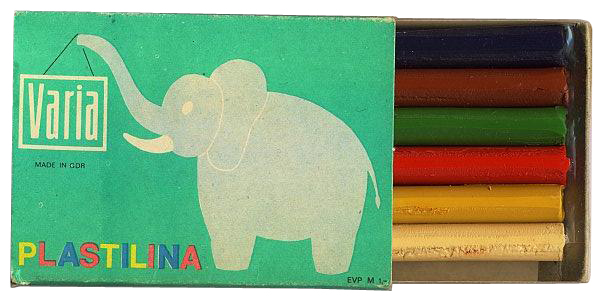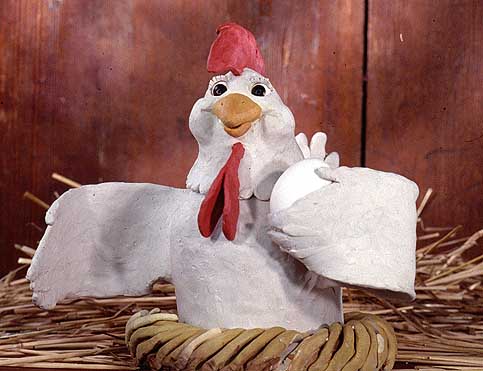|
Plasticine
Plasticine is a putty-like modelling material made from calcium salts, petroleum jelly and aliphatic acids. Though originally a brand name for the British version of the product, it is now applied generically in English as a product category to other formulations. Plasticine is used for children's play and as a modelling medium for more formal or permanent structures. Because of its non-drying property, it is a material commonly chosen for stop motion animation, including several Academy Award-winning films by Nick Park. History Franz Kolb, owner of a pharmacy in Munich, Germany, invented an oil-based modelling clay in 1880. At the time, the city was a centre for the arts, and among Kolb's circle of friends were sculptors. They complained about how with the clay they were using for modelling, their sculptures would dry too fast and that, particularly in winter, it was too difficult to work with. In order to commercialize his invention, he presented it to the Faber-Caste ... [...More Info...] [...Related Items...] OR: [Wikipedia] [Google] [Baidu] |
William Harbutt
William Harbutt (13 February 1844 – 1 June 1921) was an English artist and the inventor of Plasticine. Early life Born in North Shields, England, the son of Thomas Harbutt (5 August 1803 – 1880) and Elizabeth Whitehouse Jefcoate (27 June 1804 – 1883), Harbutt studied at the National Art Training School in London, and eventually became an associate of the Royal College of Art. Career He was headmaster of the Bath School of Art and Design from 1874 to 1877, and then opened his own art school at The Paragon Art Studio, 15 Bladud Buildings, Bath with his wife Elizabeth "Bessie" Harbutt, a well-known miniature portrait artist who exhibited works at the Royal Academy of Art and the Chicago World's Fair, and in 1887, was commissioned by Queen Victoria to produce portraits of herself and her late husband Prince Albert. Plasticine Harbutt invented Plasticine around 1897 as a non-drying modelling clay for use by his students. In 1899, Harbutt was awarded a trade mark, and in 19 ... [...More Info...] [...Related Items...] OR: [Wikipedia] [Google] [Baidu] |
Stop Motion
Stop-motion (also known as stop frame animation) is an animated filmmaking and special effects technique in which objects are physically manipulated in small increments between individually photographed frames so that they will appear to exhibit independent motion or change when the series of frames is played back. Any kind of object can thus be animated, but puppets with movable joints (puppet animation) or clay figures (claymation) are most commonly used. Puppets, models or clay figures built around an armature are used in model animation. Stop motion with live actors is often referred to as pixilation. Stop motion of flat materials such as paper, fabrics or photographs is usually called cutout animation. Terminology The term "stop-motion", relating to the animation technique, is often spelled without a hyphen as "stop motion"—either standalone or as a compound modifier. Both orthographic variants, with and without the hyphen, are correct, but the hyphenated one is th ... [...More Info...] [...Related Items...] OR: [Wikipedia] [Google] [Baidu] |
Plastilin
Modelling clay or modelling compound is any of a group of malleable substances used in building and sculpting. The material compositions and production processes vary considerably. Ceramic clay Ceramic clays are water-based substances made from clay minerals and other raw materials. They are baked at high temperatures in a process known as firing to create ceramics, such as terra cotta, earthenware, stoneware, and porcelain. Paper clay produced by pottery clay manufacturers is a clay body to which a small percentage of processed cellulose fiber has been added. When kiln-fired, the paper burns out, leaving the clay body. Consequently, the firing temperatures and glazes selection should be the same on those used with the clay body. Oil-based clay Oil-based clays are made from combinations of oils, waxes, and clay minerals. Unlike water, the oils do not evaporate and oil-based clays remain malleable even when left in dry environments for long periods. Articles made from oil ... [...More Info...] [...Related Items...] OR: [Wikipedia] [Google] [Baidu] |
Bathampton
Bathampton () is a village and Civil parishes in England, civil parish east of Bath, Somerset, Bath, England on the south bank of the River Avon, Bristol, River Avon. The parish has a population of 1,603. The Kennet and Avon Canal passes through the village and a Bathampton Toll Bridge, toll bridge links Bathampton to Batheaston on the north bank of the canal. History Bathampton Camp is a univallate Iron Age hill fort situated approximately east from the village. The site was excavated in 1904–05 and in 1952–54. Results found human and animal remains, pottery and flint flakes. The parish was part of the Hundred (county subdivision), hundred of Hampton (hundred), Hampton. The village used to be served by Bathampton railway station, but it was closed following the destructive Beeching cuts. Plasticine was manufactured in the village between 1900 and 1983 by a company founded by William Harbutt, who also lived in Bathampton. Governance The Parish councils of England, pa ... [...More Info...] [...Related Items...] OR: [Wikipedia] [Google] [Baidu] |
Bath, Somerset
Bath (Received Pronunciation, RP: , ) is a city in Somerset, England, known for and named after its Roman Baths (Bath), Roman-built baths. At the 2021 census, the population was 94,092. Bath is in the valley of the River Avon, Bristol, River Avon, west of London and southeast of Bristol. The city became a UNESCO World Heritage Site in 1987, and was later added to the transnational World Heritage Site known as the "Great Spa Towns of Europe" in 2021. Bath is also the largest city and settlement in Somerset. The city became a spa with the Latin name ' ("the waters of Sulis") 60 AD when the Romans built Roman Baths (Bath), baths and a temple in the valley of the River Avon, although List of geothermal springs in the United Kingdom, hot springs were known even before then. Bath Abbey was founded in the 7th century and became a religious centre; the building was rebuilt in the 12th and 16th centuries. In the 17th century, claims were made for the curative properties of water ... [...More Info...] [...Related Items...] OR: [Wikipedia] [Google] [Baidu] |
Play-Doh
Play-Doh, also known as Play-Dough, is a modeling compound for young children to make arts and crafts projects. The product was first manufactured in Cincinnati, Ohio, United States, as a wallpaper cleaner in the 1930s. Play-Doh was then reworked and marketed to Cincinnati schools in the mid-1950s. Play-Doh was demonstrated at an educational convention in 1956 and prominent department stores opened retail accounts. Advertisements promoting Play-Doh on influential children's television shows in 1957 furthered the product's sales. Since its launch on the toy market in the mid-1950s, Play-Doh has generated a considerable amount of ancillary merchandise such as the Fun Factory. History Origin The non-toxic, non-staining, reusable modeling compound that came to be known as "Play-Doh" was a pliable, putty-like substance concocted by Noah McVicker of Cincinnati-based soap manufacturer Kutol Products. It was devised at the request of Kroger Grocery, which wanted a product that cou ... [...More Info...] [...Related Items...] OR: [Wikipedia] [Google] [Baidu] |
Clay
Clay is a type of fine-grained natural soil material containing clay minerals (hydrous aluminium phyllosilicates, e.g. kaolinite, ). Most pure clay minerals are white or light-coloured, but natural clays show a variety of colours from impurities, such as a reddish or brownish colour from small amounts of iron oxide. Clays develop plasticity (physics), plasticity when wet but can be hardened through Pottery#Firing, firing. Clay is the longest-known ceramic material. Prehistoric humans discovered the useful properties of clay and used it for making pottery. Some of the earliest pottery shards have been radiocarbon dating, dated to around 14,000 BCE, and Clay tablet, clay tablets were the first known writing medium. Clay is used in many modern industrial processes, such as paper making, cement production, and chemical filtration, filtering. Between one-half and two-thirds of the world's population live or work in buildings made with clay, often baked into brick, as an essenti ... [...More Info...] [...Related Items...] OR: [Wikipedia] [Google] [Baidu] |
Ductility
Ductility refers to the ability of a material to sustain significant plastic Deformation (engineering), deformation before fracture. Plastic deformation is the permanent distortion of a material under applied stress, as opposed to elastic deformation, which is reversible upon removing the stress. Ductility is a critical mechanical performance indicator, particularly in applications that require materials to bend, stretch, or deform in other ways without breaking. The extent of ductility can be quantitatively assessed using the percent elongation at break, given by the equation: \% \mathrm= \left ( \frac \right )\times100 where l_ is the length of the material after fracture and l_0 is the original length before testing. This formula helps in quantifying how much a material can stretch under tensile stress before failure, providing key insights into its ductile behavior. Ductility is an important consideration in engineering and manufacturing. It defines a material's suitabil ... [...More Info...] [...Related Items...] OR: [Wikipedia] [Google] [Baidu] |
Sculpture
Sculpture is the branch of the visual arts that operates in three dimensions. Sculpture is the three-dimensional art work which is physically presented in the dimensions of height, width and depth. It is one of the plastic arts. Durable sculptural processes originally used carving (the removal of material) and modelling (the addition of material, as clay), in stone, metal, ceramic art, ceramics, wood and other materials but, since Modernism, there has been almost complete freedom of materials and process. A wide variety of materials may be worked by removal such as carving, assembled by welding or modelling, or Molding (process), moulded or Casting, cast. Sculpture in stone survives far better than works of art in perishable materials, and often represents the majority of the surviving works (other than pottery) from ancient cultures, though conversely traditions of sculpture in wood may have vanished almost entirely. In addition, most ancient sculpture was painted, which h ... [...More Info...] [...Related Items...] OR: [Wikipedia] [Google] [Baidu] |
Espacenet
Espacenet (formerly stylized as ''esp@cenet'') is a free online service for searching patents and patent applications. Espacenet was developed by the European Patent Office (EPO) together with the member states of the European Patent Organisation. Most member states have an Espacenet service in their national language, and access to the EPO's worldwide database, most of which is in English. In 2022, the Espacenet worldwide service claimed to have records on more than 140 million patent publications. History By launching Espacenet in 1998, the EPO is said to have "revolutionized public access to international patent information, releasing patent data from its paper prisons and changing forever how patents are disseminated, organized, searched, and retrieved." In 2004, i.e. in the early years of Espacenet, Nancy Lambert considered that, although free, Espacenet, like the United States Patent and Trademark Office (USPTO) database of US patents, "still tend dto have primitive sear ... [...More Info...] [...Related Items...] OR: [Wikipedia] [Google] [Baidu] |
Lanolin
Lanolin (from Latin 'wool', and 'oil'), also called wool fat, wool yolk, wool wax, sheep grease, sheep yolk, or wool grease, is a wax secreted by the sebaceous glands of wool-bearing animals. Lanolin used by humans comes from domestic sheep breeds that are raised specifically for their wool. Historically, many pharmacopoeias have referred to lanolin as wool fat ('' adeps lanae''); however, as lanolin lacks glycerides (glycerol esters), it is not a true fat. Lanolin primarily consists of sterol esters instead. Lanolin's waterproofing property aids sheep in shedding water from their coats. Certain breeds of sheep produce large amounts of lanolin. Lanolin's role in nature is to protect wool and skin from climate and the environment; it also plays a role in skin ( integumental) hygiene. Lanolin and its derivatives are used in the protection, treatment, and beautification of human skin. Composition A typical high-purity grade of lanolin is composed predominantly of long chain ... [...More Info...] [...Related Items...] OR: [Wikipedia] [Google] [Baidu] |









